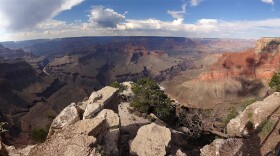There’s a map on the wall of the Cameron community center on the Navajo Nation with nearly one hundred red dots scattered all over it. They mark abandoned uranium mines. More than 500 of these mines exist on the reservation. They’re linked to cancer and other potentially deadly illnesses. But nobody knows the extent of the emotional trauma of living on land that’s contaminated. That’s the focus of a new project to raise awareness and bring healing through art.

Thirty artists gather at the Cameron community center to share a traditional Navajo meal. Fry bread sizzles in hot oil and mutton ribs cook on a campfire. As the food is prepared, local residents share stories about what it’s like to live near uranium mines.

Angela Jenkins Riggs reads a poem about her grandmother, who died of cancer:
A granddaughter should not have to walk this earth without her grandma
just because of someone else’s mistake.
A grandma should not have to say goodbye to her granddaughter
just because of someone else’s greed.
There’s anger and grief in the room…. but also hope that the artists here can make a difference. They come from all over the U.S.—painters, photographers, sculptors, both native and non-native. They hear from locals and scientists and tour this mine-riddled corner of the Navajo Nation.

Venaya Yazzie says the experience has been overwhelming.
“In a way, being an artist is a burden, especially if you’re an indigenous artist, because you take on so much, your body and senses inhale everything,” Yazzie says.

Yazzie says she’s scared to spend time in this contaminated place…. and she wants to capture that emotion in her art. That’s the hope of one of the project’s organizers, Davona Blackhorse, who studies psychology at Northern Arizona University.
“I really got frustrated in the research because there was nothing,” Blackhorse says. “That’s why we started all this, so we could maybe create some kind of interventions, and we were thinking art interventions.”

Blackhorse wants to immerse the artists in Navajo culture, and show them how connected the people are to a land that’s making them sick. “I wanted them to see the animals that come from the land, they eat the plants, they drink the water, and this stuff moves through us.”

Uranium is in the water, the dust, and the bodies of some people who live here. It’s been linked to cancer, lung disease and kidney damage, but there’s little data on the psychological effects. Blackhorse says few understand what the Navajo are going through.
“They think our struggles are over, but they’re actually still happening right now,” Blackhorse says. “People are still really emotional, still really hurt and traumatized by this. I think we just want to help people heal from all that.”
She partnered with the Flagstaff Arts Council to put together an intense training for artists. Part of it is visiting abandoned uranium mines.

Amy Martin is a Flagstaff photographer. She stands on a rocky bluff overlooking houses and corrals. “So we’ve just taken our buses up through an area that had been closed off, with signs that say ‘Do Not Enter,’” she says. This mine has been here for decades. The warning signs went up just last year.

Martin says she wants to try to capture what she’s learned here in portraits of the people affected. “The extent of the effects of the mining both on the landscape as well as on individuals and families and communities… I’m almost ashamed I didn’t know that before,” she says.
Another artist, Tracy Watchman, is from Grand Falls just south of here. She drives through Cameron often but didn’t know until now the extent of what people are dealing with. “It’s real overwhelming,” she says. “It breaks my heart that people live so close to these areas.”
Watchman says her whole outlook now is changed. That’s her inspiration to go home and get to work.
This project will culminate in an art exhibition called “Hope and Trauma in a Poisoned Land.” It opens next fall at the Coconino Center for the Arts in Flagstaff.








